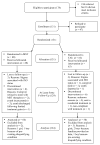Two-year follow-up of a randomized effectiveness trial evaluating MST for juveniles who sexually offend
- PMID: 24188082
- PMCID: PMC4490861
- DOI: 10.1037/a0034710
Two-year follow-up of a randomized effectiveness trial evaluating MST for juveniles who sexually offend
Abstract
Building on prior efficacy trials (i.e., university-based, graduate students as therapists), the primary purpose of this study was to determine whether favorable 12-month outcomes, obtained in a randomized effectiveness trial (i.e., implemented by practitioners in a community mental health center) of multisystemic therapy (MST) with juveniles who had sexually offended (JSO), were sustained through a second year of follow-up. JSO (n = 124 male youth) and their families were randomly assigned to MST, which was family based and delivered by community-based practitioners, or to treatment as usual (TAU), which was primarily group-based cognitive-behavioral interventions delivered by professionals within the juvenile justice system. Youth averaged 14.7 years of age (SD = 1.7) at referral, were primarily African American (54%), and 30% were Hispanic. All youth had been diverted or adjudicated for a sexual offense. Analyses examined whether MST effects reported previously at 1-year follow-up for problem sexual behaviors, delinquency, substance use, and out-of-home placement were sustained through a second year of follow-up. In addition, arrest records were examined from baseline through 2-year follow-up. During the second year of follow-up, MST treatment effects were sustained for 3 of 4 measures of youth problem sexual behavior, self-reported delinquency, and out-of-home placements. The base rate for sexual offense rearrests was too low to conduct statistical analyses, and a between-groups difference did not emerge for other criminal arrests. For the most part, the 2-year follow-up findings from this effectiveness study are consistent with favorable MST long-term results with JSO in efficacy research. In contrast with many MST trials, however, decreases in rearrests were not observed.
Similar articles
-
Long-term effects of multisystemic therapy for problem sexual behaviors: A 24.9-year follow-up to a randomized clinical trial.J Consult Clin Psychol. 2021 May;89(5):393-405. doi: 10.1037/ccp0000646. Epub 2021 Apr 29. J Consult Clin Psychol. 2021. PMID: 33914570 Clinical Trial.
-
Multisystemic therapy for juvenile sexual offenders: 1-year results from a randomized effectiveness trial.J Fam Psychol. 2009 Feb;23(1):89-102. doi: 10.1037/a0014352. J Fam Psychol. 2009. PMID: 19203163 Free PMC article. Clinical Trial.
-
Systematic Review and Meta-Analysis: Multisystemic Therapy and Functional Family Therapy Targeting Antisocial Behavior in Adolescence.J Am Acad Child Adolesc Psychiatry. 2025 Apr;64(4):427-446. doi: 10.1016/j.jaac.2024.10.008. Epub 2024 Oct 18. J Am Acad Child Adolesc Psychiatry. 2025. PMID: 39428056
-
An independent effectiveness trial of multisystemic therapy with juvenile justice youth.J Clin Child Adolesc Psychol. 2006 Jun;35(2):227-36. doi: 10.1207/s15374424jccp3502_6. J Clin Child Adolesc Psychol. 2006. PMID: 16597218 Clinical Trial.
-
A Systematic Review of Multisystemic Therapy in Adolescent Sex Offenders.J Am Acad Psychiatry Law. 2024 Mar 11;52(1):51-60. doi: 10.29158/JAAPL.230117-23. J Am Acad Psychiatry Law. 2024. PMID: 38467440
Cited by
-
The need for a comprehensive public health approach to preventing child sexual abuse.Public Health Rep. 2014 May;129(3):222-8. doi: 10.1177/003335491412900303. Public Health Rep. 2014. PMID: 24790251 Free PMC article. No abstract available.
-
Adolescents with harmful sexual behaviours in New Zealand: could assessment of personality-based classifications help guide therapeutic interventions?Psychiatr Psychol Law. 2023 Jul 5;31(5):842-858. doi: 10.1080/13218719.2023.2214939. eCollection 2024. Psychiatr Psychol Law. 2023. PMID: 39318880 Free PMC article.
-
Changes in J-SOAP-II and SAVRY Scores Over the Course of Residential, Cognitive-Behavioral Treatment for Adolescent Sexual Offending.Sex Abuse. 2017 Jun;29(4):342-374. doi: 10.1177/1079063215595404. Epub 2015 Jul 21. Sex Abuse. 2017. PMID: 26199271 Free PMC article.
-
Long-Term Effects of Home-Based Family Therapy for Non-responding Adolescents With Psychiatric Disorders. A 3-Year Follow-Up.Front Psychol. 2020 Oct 23;11:475525. doi: 10.3389/fpsyg.2020.475525. eCollection 2020. Front Psychol. 2020. PMID: 33192753 Free PMC article.
-
Examining Practices for Youth Illegal Sexual Behaviors which May Warrant De-Implementation: Overview and Recommendations.Res Child Adolesc Psychopathol. 2025 May;53(5):761-770. doi: 10.1007/s10802-025-01301-5. Epub 2025 Mar 10. Res Child Adolesc Psychopathol. 2025. PMID: 40063208 Review.
References
-
- Borduin CM, Henggeler SW, Blaske DM, Stein R. Multisystemic treatment of adolescent sexual offenders. International Journal of Offender Therapy and Comparative Criminology. 1990;34:105–113.
-
- Borduin CM, Letourneau EJ, Henggeler SW, Saldana L, Swenson CC. Treatment manual for Multisystemic Therapy with juvenile sexual offenders and their families. Charleston, SC: Department of Psychiatry and Behavioral Sciences, Medical University of South Carolina; 2005. Unpublished manual.
-
- Borduin CM, Schaeffer CM, Heiblum N. A randomized clinical trial of multisystemic therapy with juvenile sexual offenders: Effects on youth social ecology and criminal activity. Journal of Consulting and Clinical Psychology. 2009;77:26–37. - PubMed
-
- Elliott DS, Huizinga D, Ageton SS. Explaining delinquency and drug use. Beverly Hills, CA: Sage; 1985.
-
- Finkelhor D, Ormrod R, Chaffin M. Juveniles who commit sex offenses against minors. Juvenile Justice Bulletin 2009 Dec;
Publication types
MeSH terms
Grants and funding
LinkOut - more resources
Full Text Sources
Other Literature Sources
Medical


